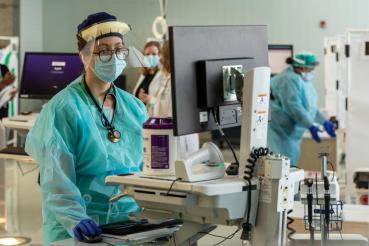Lately, the course of the COVID-19 pandemic has seemed like two trains running alongside each other in opposite directions. More than 168 million vaccinations against COVID-19 have been administered so far in the United States, which has rapidly increased vaccine distribution. At the same time, the number of cases in the U.S. has increased, rising by 19% over the past two weeks. Infectious disease experts and other health care officials also are concerned about the emergence of variants (mutations) of SARS-CoV-2 (the name of the virus that causes COVID-19) that may be less susceptible to vaccines, particularly variants first discovered in South Africa and Brazil.
To help people better understand the situation, John Segreti, MD — a hospital epidemiologist and the medical director of infection control at Rush University Medical Center — answered questions about a possible surge of cases, the vaccines vs. the variants and much more.
A lot of public health leaders, including the director of the federal Centers for Disease Control and Prevention, are warning that we may be experiencing another surge of COVID-19 cases. What’s your assessment of the situation?
Segreti: We’re definitely seeing an increase in the number of cases, but the percent of positives in the people being tested for COVID-19 hasn’t reached the levels we were at in October and November of last year or March of last year. Maybe it’ll just be a little bump, and then cases will start to go down, or maybe this is the beginning of another surge. We’ll know in two or three weeks.
Which of those scenarios do you think is more likely?
We are intervening, and we’re vaccinating, so I don’t expect things will be as bad as they were in the spring or fall of last year. I think we’ll see an increase in cases, but I don’t think it’ll get to the point we were at in November of last year.
Why do you think it won’t be as bad this time? Is it because of the vaccines, or something else?
Vaccination is very important, also the number of people who already have been infected with the COVID-19 virus and are theoretically immune matters. I think we’re doing more in Chicago and in Illinois in terms of masking and separation than people are in other states. The wild card in all of this are the variants of the virus. Are we going to see more of them, and will we see variants that are less affected by the vaccines? That’s what everyone’s concerned about.
What do we know about the vaccines’ effectiveness against the variants?
From laboratory studies, we know that vaccinated people’s blood serum will neutralize the virus variants in vitro (in a test tube or culture dish). In the South Africa portion of the clinical trial of Johnson & Johnson’s vaccine, the vaccine was only 50-some percent effective in preventing infections, but it was very protective in preventing hospitalizations and death.
As far as the mRNA vaccines (made by Pfizer and Moderna), we only know about the results in vitro, because the variants weren’t circulating when they were in clinical trials. I would expect they would perform the same as the J&J vaccine, because all the vaccines are targeting the virus’ spike protein. It probably doesn’t matter how you develop the antibodies to that protein.
Can you talk some more about the vaccines’ effectiveness in preventing severe disease?
So far, when people have been infected, they’ve been identified because of asymptomatic screening, or they had very minor symptoms like a runny nose or a sore throat, and they got a test. I’m not aware of any reports of anyone who’s been vaccinated who’s been hospitalized on a ventilator, and we’ve given at least one dose to more than 100 million people.
That’s roughly one-third of the population of the United States. How many more do we need to vaccinate to reach herd immunity, the point where enough people are immune that it makes infection unlikely among the population overall?
The percentage of people who need to be immune in order to achieve herd immunity varies with each disease. For example, herd immunity against measles requires about 95% of a population to be vaccinated. The remaining 5% will be protected by the fact that measles will not spread among those who are vaccinated.
For polio, the threshold is about 80%. The proportion of the population that must be vaccinated against COVID-19 to begin inducing herd immunity is not known. We’ll know what that number is once we reach it, and we’ll know we’ve reached it when we don’t have active transmission on a wide scale.
If we need to get to 80% of the population or more vaccinated for herd immunity, we have to persuade the 20% of people that a recent survey said won’t get the vaccine, or won’t get it unless they’re required to do it. What would you say to them to try to convince them?
I tell people, if you get vaccinated, you probably won’t get infected, and if you don’t get infected, you won’t infect other people. If you do get infected after vaccination, you’re much less likely to end up in the hospital or dead.
Regarding that last point, how much do we know about whether or not vaccinated people can have asymptomatic infections and spread the virus to others?
It’s not conclusive, but what we know in the U.S., based on a trial the CDC conducted with health care workers, and also data from Israel, that people who are vaccinated are much less likely to transmit infection. It’s not 100%, but it’ll go a long way to help limit the spread of COVID.
You talked earlier about the flu vaccine, which people need to get every year to stay immune. Do you think we’ll need to have annual COVID-19 vaccinations?
If COVID is like any other coronavirus, they come back every year just like influenza does. I expect we’ll be getting variants and probably will require immunizations on a regular basis. Whether it’s once a year, once every six months, once every two years? We don’t know. But I expect we’ll need more vaccinations in the future.
Given all the difficulties we’ve had vaccinating people the first time, how are we going to do it every year?
Right now, we’re trying to immunize everyone in a short period of time in central locations, because of the special handling the Pfizer and Moderna vaccines need. If we had a vaccine that didn’t require freezing, that could be put in a refrigerator and is ready to inject in a syringe, like the flu vaccine is, I can see physicians giving it like the flu vaccine in their office. I think the Johnson & Johnson’s vaccine comes close to that. There’s another vaccine from Novavax that may meet those criteria as well.
One of the advantages of the new ways of producing these vaccines — whether it’s mRNA (which is used in the Pfizer and Moderna vaccines), or a viral vector (Johnson & Johnson) or with the with Novavax having insect cells produce the spike protein, you can make the changes a lot faster than you can with traditional vaccine manufacturing. You may be able to produce designer vaccines for whatever variant is circulating and have it ready a lot faster.
Thanks for answering these questions. You’ve been talking about COVID-19 for more than a year now, and you must badly want to talk about something else. How have you stayed positive and kept going all this time?
What’s giving everyone a lot of hope has been the vaccines. The vaccines have really held up. They’re doing a lot better than I expected, and they’re continuing to perform well. That’s a real positive and reason for hope. When we eventually get through this, it’ll be because of the vaccinations.




